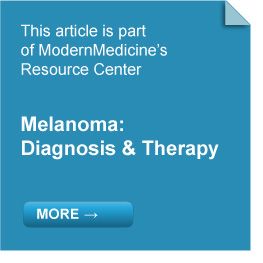- Acne
- Actinic Keratosis
- Aesthetics
- Alopecia
- Atopic Dermatitis
- Buy-and-Bill
- COVID-19
- Case-Based Roundtable
- Chronic Hand Eczema
- Chronic Spontaneous Urticaria
- Drug Watch
- Eczema
- General Dermatology
- Hidradenitis Suppurativa
- Melasma
- NP and PA
- Pediatric Dermatology
- Pigmentary Disorders
- Practice Management
- Precision Medicine and Biologics
- Prurigo Nodularis
- Psoriasis
- Psoriatic Arthritis
- Rare Disease
- Rosacea
- Skin Cancer
- Vitiligo
- Wound Care
Article
Sentinel lymph node biopsy appropriate for certain thin melanomas
Author(s):
Sentinel lymph node (SLN) status represents the most important prognostic factor for disease-specific survival in primary cutaneous melanomas, said Christopher K. Bichakjian, M.D., at the 70th annual meeting of the American Academy of Dermatology. However, he says, its impact on overall survival remains unclear.

Key Points
San Diego - Sentinel lymph node (SLN) status represents the most important prognostic factor for disease-specific survival in primary cutaneous melanomas, said Christopher K. Bichakjian, M.D., at the 70th annual meeting of the American Academy of Dermatology. However, he says, its impact on overall survival remains unclear.

The Multicenter Selective Lymphadenectomy Trial-I, however, showed no difference in overall survival for patients with intermediate-thickness melanomas who underwent sentinel lymph node biopsy (SLNB; Morton, Thompson JF, Cochran AJ, et al. N Engl J Med. 2006;355(13):1307-1317). Nevertheless, Dr. Bichakjian says this study did show a significant five-year disease-free survival advantage for patients who underwent SLNB versus those who didn't (78.3 versus 73.1 percent, respectively, P=0.009).
Understanding guidelines

Dr. Bichakjian says patients with T1a melanoma face a very low risk of nodal metastases and have a five-year overall survival rate around 97 percent (Balch CM, Gershenwald JE, Soong SJ, et al. J Clin Oncol. 2009;27(36):6199-6206. Epub 2009 Nov 16). Likewise, a review of 24 retrospective studies reporting SLNB status for melanomas 1 mm thick or less showed a positivity rate of 5.1 percent (Andtbacka RH, Gershenwald JE. J Natl Compr Canc Netw. 2009;7(3):308-317).
In contrast, he says that in T1b (less than or equal to 1 mm, with ulceration or at least one mitosis per mm2) melanomas measuring between 0.76 mm and 1 mm in thickness, "There is a somewhat higher risk of nodal involvement."
AJCC data suggest that in such melanomas, the risk of occult nodal metastases climbs to around 10 percent (ibid. Balch CM, Gershenwald JE, Soong SJ, et al. J Clin Oncol. 2009;27(36):6199-6206. Epub 2009 Nov 16). AJCC data also show a 10-year survival rate of 93 percent for stage T1a melanomas, "But in stage T1b, it drops to 85 percent. That's an appreciable difference between T1a and T1b, which explains why mitotic rate was included" in the AJCC's melanoma staging guidelines, Dr. Bichakjian says.
"Regardless of Breslow thickness, ulceration and other factors, survival decreases dramatically with an increased MR. Importantly, we need to see MR as a continuous variable. An MR of eight is very different than an MR of one," despite the fact that both numbers fall within T1b staging criteria, Dr. Bichakjian says.
"To put that in a clinical context, if we're talking about a patient with a melanoma that is 0.8 mm in depth with an MR of exactly one, we must realize that this combination of characteristics may not warrant SLNB, in the absence of other troublesome criteria," he says.
Clinically, he adds, "You will probably see quite a few melanomas that have an MR of 1 per mm2. Pathologists tend to look hard for mitoses, because MR can be used to upstage melanomas."
Conversely, "If you have a patient with a 0.6 mm melanoma with an MR of eight per mm2, that might be very significant," Dr. Bichakjian says. In the range of five to 9.99 mitoses per mm2, five-year survival averages around 78 percent, versus around 98 percent for patients with zero mitoses (Thompson JF, Soong SJ, Balch CM, et al. J Clin Oncol. 2011;29(16):2199-2205. Epub 2011 Apr 25. Erratum in: J Clin Oncol. 2011;29(21):2949).
Newsletter
Like what you’re reading? Subscribe to Dermatology Times for weekly updates on therapies, innovations, and real-world practice tips.











